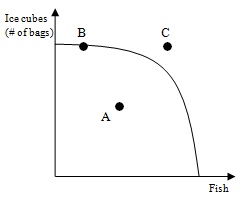Problem 1. Math Review :
Suppose that you have two straights lines, Line A and Line B. The points (y = 0, x = 8) and (y = 12, x = 2) lie on Line A. The points (y = 10, x = 31) and (y = 4, x = 13) lie on Line B.
a. Graph Line A and Line B.
b. Find the slope for each line.
c. For Line A, are x and y positively or negatively related? What about line B?
d. Write the equations of Line A and Line B in slope-intercept form.
e. What is the point of intersection between Line A and Line B?
f. Find the y-intercept and x-intercept of both lines.
Problem 2. Production Possibility Frontier
Zach lives next to Lake Mendota. During the winter, Zach can produce ice cubes or catch fish. The graph below illustrates his production possibility frontier:

a. Is point A feasible? Is it efficient?
b. Is point B feasible? Is it efficient?
c. Is point C feasible? Is it efficient?
Problem 3. Production Possibility Frontier and Opportunity Cost
Mooland is a community that produces two goods, cheese curds and milk. The following table describes the production possibility frontier (PPF) for Mooland during 2008. Assume the PPF is linear between the points listed in the table.
Points on PPF Milk (Gallons) Cheese Curds (Pounds)
A 0 100
B 20 95
C 40 80
D 75 4
E 76 0
a. Draw a graph of Mooland’s PPF for 2008 based on the information contained in the table. In your graph, measure cheese curds (C) on the vertical axis and milk (M) on the horizontal axis.
b. Suppose Mooland is currently producing at point C on their PPF. What is the opportunity cost of producing one additional pound of cheese curds? What is the opportunity cost of producing one additional gallon of milk?
c. If Mooland is currently producing at combination A, what is the opportunity cost of producing 20 more gallons of milk?
d. What is happening to the opportunity cost of producing more milk if we move from point A to point C? Explain your answer.
Problem 4. Comparative Advantage
Suppose Ann and Drew are doing Biology and Math homework. In one hour, Ann can solve 5 Biology questions or 10 Math questions, or any other combination lying on the line between those two points. In the same amount of time, Drew can solve 10 Biology questions or 15 Math questions, or any other combination lying on the line between those two points.
a. What is the opportunity cost of solving 1 Math question for Ann? What about for Drew?
b. What is the opportunity cost of solving 1 Biology question for Ann? What about for Drew?
c. Who has the absolute advantage in doing Biology homework and Math homework?
d. Suppose they work together. Who will specialize in Math problems and who will specialize in Biology problems?
e. If they were to trade with each other, what is the price range (in terms of number of Math problems) acceptable to both Ann and Drew for a Biology question?